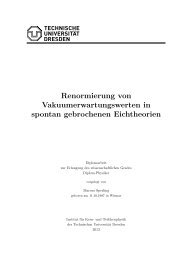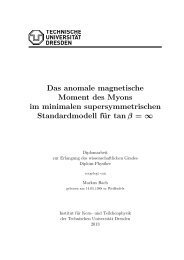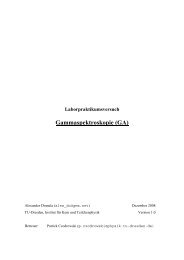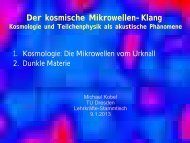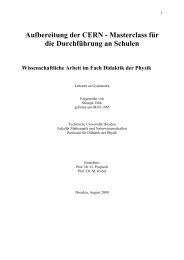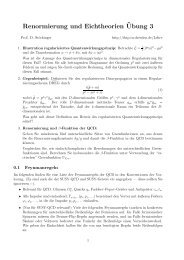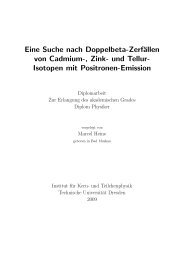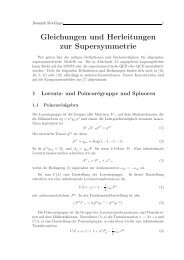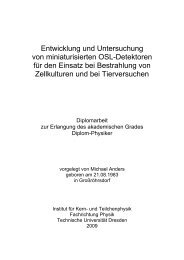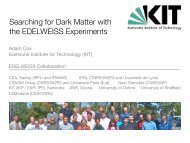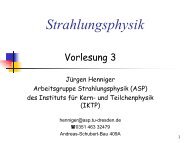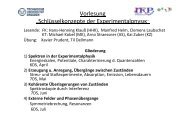a design study for a cobra upgrade to - Institut für Kern- und ...
a design study for a cobra upgrade to - Institut für Kern- und ...
a design study for a cobra upgrade to - Institut für Kern- und ...
You also want an ePaper? Increase the reach of your titles
YUMPU automatically turns print PDFs into web optimized ePapers that Google loves.
18 3 The COBRA experiment<br />
They are commercially supplied with a red passivation, which<br />
prevents the degradation of the crystal material due <strong>to</strong> oxidation<br />
processes or moisture. This passivation has been identified as the<br />
main backgro<strong>und</strong> source in a <strong>for</strong>mer test set-up with 16 crystals.<br />
Crystals with a low backgro<strong>und</strong> optimised colourless passivation<br />
had a reduced backgro<strong>und</strong> level of about a fac<strong>to</strong>r 10 [24] and are<br />
investigated in the current set-up with eight crystals of two different<br />
passivations. The left side of figure 3.2 shows one of 64<br />
CZT detec<strong>to</strong>rs with colourless passivation, which will be installed<br />
soon.<br />
CZT detec<strong>to</strong>rs operate with a high voltage of about one kV/cm,<br />
being applied between the cathode (bot<strong>to</strong>m side of crystal in figure<br />
3.2) and a coplanar grid anode (upper side of crystal in figure<br />
3.2). CZT detec<strong>to</strong>rs with a common anode have, due <strong>to</strong> different<br />
charge carrier mobilities and trapping times, a signal, which<br />
depends on the collection time and point of interaction. Thus,<br />
a suitable energy resolution could not be obtained. The coplanar<br />
grid anode has been developed as electron-only readout (see<br />
[25]) and therewith energy resolutions of <strong>und</strong>er 1 % (FWHM at<br />
662 keV) can be achieved. Typical crystals used <strong>for</strong> the COBRA<br />
pro<strong>to</strong>type set-up have resolutions of aro<strong>und</strong> 3-5 % [8].<br />
3.3 Motivation <strong>for</strong> scintilla<strong>to</strong>r <strong>upgrade</strong><br />
Besides the 0νββ decays, the 2νββ transitions are of physical interest as<br />
well. The 2νββ decay of 116 Cd in<strong>to</strong> the first excited state is of interest<br />
<strong>for</strong> this thesis. Figure 3.3 shows the transitions of 116 Cd in<strong>to</strong> the gro<strong>und</strong><br />
and first excited state of 116 Sn. The decay of 116 Cd in<strong>to</strong> the first excited<br />
state is accompanied by the emission of a 1294 keV pho<strong>to</strong>n.<br />
The current Cobra experiment has a low efficiency <strong>for</strong> gamma ray detection.<br />
Only about every tenth of the in this decay emitted 1294 keV<br />
pho<strong>to</strong>ns interacts with the small CZT detec<strong>to</strong>rs and the full energy of<br />
these pho<strong>to</strong>ns is detected <strong>for</strong> only 1% of the decays. This leads <strong>to</strong> a<br />
small detection efficiency <strong>for</strong> this double beta decay. Accordingly, an<br />
<strong>upgrade</strong> of the current COBRA setup <strong>to</strong> enable a better gamma ray detection<br />
is desirable.<br />
The aim of this thesis is there<strong>for</strong>e <strong>to</strong> develop a <strong>design</strong> of a COBRA <strong>upgrade</strong><br />
with a high detection efficiency <strong>for</strong> the decay of 116 Cd in<strong>to</strong> the<br />
first excited state. A desired <strong>upgrade</strong> should achieve high detection ef-



